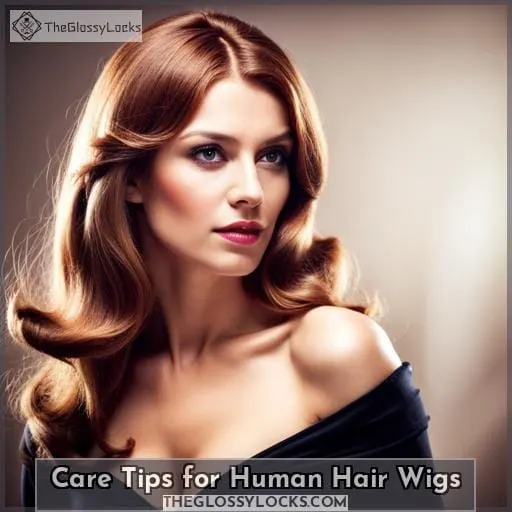This site is supported by our readers. We may earn a commission, at no cost to you, if you purchase through links.
 So you want to know how to stop synthetic hair from frizzing? You’re not alone. Synthetic wigs are an increasingly popular fashion accessory, but all too often they end up looking dry and unkempt because of the dreaded frizz.
So you want to know how to stop synthetic hair from frizzing? You’re not alone. Synthetic wigs are an increasingly popular fashion accessory, but all too often they end up looking dry and unkempt because of the dreaded frizz.
But don’t despair – there are several tricks you can use to prevent your synthetic wig from becoming a matted mess.
Table Of Contents
Key Takeaways
- Use wig-specific products with a low pH and no sulfates for weekly washing.
- Avoid high heat sources like ovens and opt for a handheld steamer.
- Brush through sections with a wide-tooth comb to prevent tangles and frizz.
- Store synthetic wigs on a stand away from dust, odors, and direct sunlight.
Causes of Frizz in Synthetic Wigs
Daily use and exposure to heat can cause significant damage to synthetic wigs, leading to static electricity and deep-rooted frizz. Heat dries out the fibers in these wigs, so it is important that you wash them once a week with wig-specific products that are free of high pH levels or sulfate content.
Daily Use and Exposure to Heat
Daily use and exposure to heat can make your wig look wild, so be sure to take steps to keep it looking smooth! Heat dries out synthetic fibers, leading to static electricity and frizz. To prevent this, use dryer sheets for minimal flyaways or flat-iron one-inch sections with temperature control.
Avoid high heat sources like ovens and opt for a handheld steamer instead of conditioners, which may damage the cap.
Regularly maintain human hair wigs with care products such as shampooing and blow-drying or trimming damaged ends by a professional.
Heat and Synthetic Wigs
Heat has a harmful effect on synthetic wigs, causing them to become frizzy and flyaway.
- Use temperature-controlled tools when styling.
- Avoid high heat sources such as ovens.
- Apply leave-in conditioner sparingly to the wig cap for softening hair fibers. Regular care and maintenance are also essential, including trimming damaged ends with scissors and using a conditioning spray or scarf in extreme weather conditions!
Washing Synthetic Wigs
Wash your synthetic wig once a week with special products to keep frizz at bay. Use a wide-tooth comb for detangling and avoid high pH, sulfate-containing shampoos or conditioners. Leave-in conditioner helps soften the hair fiber and eliminate static electricity, while flat irons can add shape and reduce flyaways.
Methods for Preventing Frizz on Synthetic Wigs
Are you looking to keep your synthetic wig from frizzing? One way to prevent this is by using dryer sheets. Not only do they smooth out the hair fibers, but they also help reduce static electricity and create a more polished look.
Smooth Hair Fibers With Dryer Sheets
Smooth your synthetic wig quickly and easily with dryer sheets to instantly eliminate any pesky frizz! Dryer sheets provide static control, fabric softener tricks, and effective frizz reduction. Hair fiber smoothing is made a breeze with the help of these heat-friendly synthetic wigs.
Brush Through Sections Using a Wide-tooth Comb
To help keep your synthetic wig looking sleek and free of flyaways, brush through sections with a wide-tooth comb. Wider teeth allow for more surface area to spread the detangling product evenly and prevent tugging on hair.
It also helps redistribute natural oils throughout the strands while reducing frizz caused by static electricity.
Additionally, it’s important to choose combs that are designed specifically for wigs as they will reduce damage due to corrosion or warping over time.
- Wider teeth offer better coverage when detangling products are applied
- Redistributes natural oils throughout strands
- Helps reduce static electricity, which causes frizzing
- Choose combs made specifically for wigs to avoid damaging them from corrosion or warping
- Regular use keeps hair tangle-free and shiny
Flat Iron One-inch Sections of the Wig
Tame flyaways with a flat iron and take your synthetic wig to the next level! Start by brushing sections of hair with a wide-tooth comb, then heat style one-inch sections at low temperatures. Use dryer sheets or leave-in conditioners for extra smoothness. For more intense frizz, use garment steamers followed up by flat irons.
Don’t forget to cool down the hair after using heated tools and protect wigs from extreme weather conditions! Make sure you have all the necessary products like heat protectant and conditioning sprays on hand when styling—you’ll be rocking that perfect ‘do in no time.
Storage and Maintenance Tips for Synthetic Wigs
If you’re looking to keep your synthetic wigs in prime condition and prevent frizz, it’s important to store them on a stand, away from dust and direct sunlight. Regularly moisturizing them with a conditioning spray is also essential for keeping the fibers hydrated and healthy.
Store Wigs on a Stand
When storing your synthetic wig, ensure it is kept on a stand to avoid friction and maintain its shape. This will prevent odors from building up, tangles from forming, and the wig’s overall shape from becoming distorted.
To maximize protection for your wig, store it away from dust, keep it out of direct sunlight, use a conditioning spray or scarf in extreme weather conditions, and never place it near ovens or other sources of high heat.
For optimal results, always comb through sections with wide-tooth combs before storage to reduce flyaways and frizziness.
Keep Wigs Away From Dust and Direct Sunlight
Protect your synthetic wig from dust and direct sunlight by storing it away in a cool, dry place. Use protective scarves when necessary to shield against extreme weather conditions. Incorporate moisturizing techniques with top-quality wig care products for maximum protection of your prized possession.
To prevent dust build up, store the wig on a stand or use air drying techniques as needed. Sunlight exposure can be damaging, so keep wigs out of direct rays whenever possible for optimal results.
With proper maintenance and careful attention to detail, you can ensure that your synthetic hair remains frizz-free all season long!
Moisturize Wigs With Conditioning Spray
Spray a light mist of conditioning product onto your synthetic wig to keep it moisturized and looking its best. Use products specifically designed for wigs, avoiding high pH and sulfate-containing items.
Leave-in conditioner gently untangles frizz while hot air brushes with ceramic barrels add volume and shape. Regularly use heat tools with temperature controls for styling human hair wigs, followed by additional conditioning treatments when needed.
Care Tips for Human Hair Wigs
Maintaining human hair wigs requires regular combing and weekly shampooing, followed by blow-drying to maintain smoothness. Additionally, using a heat protectant when styling is essential for preventing frizz or damage from high temperatures.
With the right care and maintenance routine, you can enjoy your human hair wig for much longer without worrying about frizzy ends or flyaways.
Regular Combing and Shampooing
You’ll want to regularly comb and shampoo your human hair wig for optimal smoothness. Detangle strands with a wide-tooth comb before washing. Use a sulfate-free shampoo and conditioner made for wigs weekly.
Rinse thoroughly, apply leave-in conditioner, and let air dry on a stand. Finally, style as usual with heat protectant. Maintaining your human hair wig with regular combing and washing keeps the fibers smooth and frizz-free.
Blow-drying to Maintain Smoothness
Drying your human hair wig regularly with a blow dryer helps it stay silky smooth, like a calm ocean on a breezy day. Use heat protectant to prevent frizz and lock in moisture! Styling techniques such as flat ironing or curling can help you achieve the desired look while still maintaining that soft finish.
Using Heat Protectant When Styling
Fight frizz and nourish those luscious locks when styling by covering that ‘do in a heat-protecting mist before taking the flat iron to it. Choosing the right protectant is key. Look for ingredients like silicone and dimethicone to ward off pesky flyaways.
With proper application, you can have frizz-free styles with no fear of heat damage! Don’t forget product recommendations from experts too. Try out light oils or thermo sprays before styling your hair wig for an extra layer of protection.
Get creative with your look while also taking preventative measures against dreaded breakage caused by excess heat usage!
Additional Tips for Frizz Prevention
Tackling frizzy synthetic wigs can be a daunting task, but with these tips and tricks, you’ll be sure to achieve a smooth finish. Whether you’re worried about frizz or want to explore products for preventing it, seeking professional help is always recommended.
Seek Professional Help if Worried About Frizz
If you’re concerned about frizz in your synthetic wig, it’s best to seek professional help. Wig experts and hair stylists can provide personalized advice and recommend products to tame frizz based on your wig type, lifestyle factors, and hair needs.
- Schedule a consultation.
- Ask questions.
- Follow recommendations.
With professional guidance, you can troubleshoot and prevent frizz for good. Expert advice empowers you to care for your wig with confidence.
Explore Frizz-free Products
You’d be wise to explore frizz-free liquid enhancements like serum to tame unruly tresses. Look for a product tailored for your hair type and read user reviews – it’s often the best way to gauge the long-term effectiveness of any product.
When applying, use small amounts distributed evenly through damp hair; avoid overloading strands with too much product or you risk weighing them down instead of giving them lift! Experimenting with application techniques can also help find what works best for you and keep unwanted frizz away in the long run.
Share Tips on Social Media
Utilize Instagram Insights and Twitter Polls to engage your audience and ask for their best tips on styling and caring for synthetic wigs. The feedback you receive can provide great ideas for future posts. Join Facebook Groups dedicated to wigs and hair extensions to exchange knowledge with other members.
Share your own techniques for detangling and smoothing synthetic fibers. Recommend your favorite wig accessories like detangling brushes, hairsprays and heat protectants.
Ask your followers how they protect the fibers and strands of their synthetic wigs from matting and tangling. Provide tips you’ve learned for gently brushing through the hair and separating strands. Suggest using wig shampoos and conditioners formulated specifically for synthetic fibers, as they can help reduce friction.
Advise trimming away any single strands that may be looping around others and causing knots. Share product recommendations for pre-styling serums and creams that help the fibers stay slick and smooth.
How to De-frizz Once Frizz Has Occurred
Unfortunately, frizz can happen even if you’re diligent about preventing it. To get your synthetic wig looking silky smooth again, use a combination of heat tools, leave-in conditioners, and gentle brushing to tame flyaways and static.
Using a Steamer and Wide-tooth Comb
To achieve silky smooth strands, remember that an ounce of prevention is worth a pound of cure and de-frizz hair using a handy steamer with a wide-toothed comb. Hold sections of hair taut and hover the steamer over frizzy areas, then follow by gliding the wide teeth of the comb through the hair.
This softens hair and detangles it for a polished finish. Regular conditioning and proper storage of hair are crucial as well.
Applying Frizz-reducing Products
After smoothing with the comb, lightly press frizz-fighting serum onto wig ends for a polished look. Use a pea-sized amount of product to combat static and reduce flyaways. For an extra layer of protection, apply a heat protectant spray before using heated styling tools.
Trimming the Synthetic Hair if Necessary
If you find yourself dealing with excess frizz, you may need to trim the wig to restore its original shape.
- Use a blade or scissors when cutting.
- Avoid cutting too much at once.
- Trim from the ends up.
For more styling secrets, consider using hot air brushes or flat irons on low heat settings. Even in humid climates, your synthetic wigs will remain smooth and manageable with regular care and proper products.
Remember to give careful attention to maintaining a healthy wig by taking extra time for conditioning treatments with leave-in conditioners before styling.
Conclusion
You’ve come to the right place if you’re looking for practical advice on how to prevent synthetic hair from frizzing. Frizz in synthetic wigs is caused by daily use and exposure to heat, as well as washing with the wrong products.
The good news is that with the right tools and techniques, you can keep your wig looking smooth and frizz-free.
To start, use dryer sheets to smooth hair fibers. Simply rub a dryer sheet over the wig to reduce static and frizz. Next, brush through sections with a wide-tooth comb. This will help detangle the hair and prevent further frizzing.
Another helpful tip is to apply leave-in conditioner to untangle and soften frizzy hair. This will add moisture and make the hair more manageable. Additionally, make sure to store synthetic wigs on a stand to maintain their shape and keep them away from dust, odors, and direct sunlight.
When it comes to human hair wigs, regular combing and weekly shampooing are essential. This will help keep the hair smooth and prevent tangles. Blow-drying can also be beneficial in maintaining smoothness.
By following these tips and giving your synthetic hair a little extra care, you can keep it looking fabulous and frizz-free.









